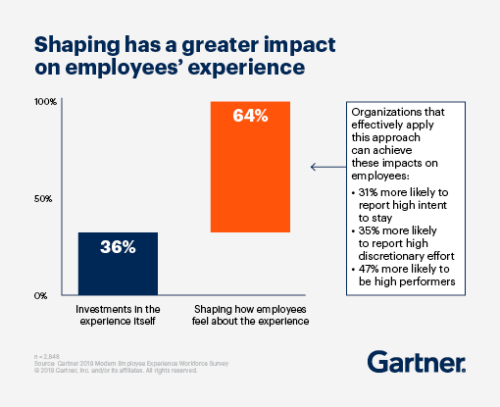How To Increase Team Engagement
If you are reading this, you are most likely a leader that sees value in teams with a high level of engagement. Personally, I have been passionate about employee engagement throughout my entire career, but I have had varying levels of success mobilizing efforts that really move the needle.
 Gartner customer experience research shows the value of team engagement:
Gartner customer experience research shows the value of team engagement:
Two-thirds of the drivers of customer satisfaction are due to “feel factors,” or how customers feel during and about their experience. HR leaders should take this same approach to employee experience, focusing on influencing and improving employees’ feelings about their overall experience through the use of psychological, motivational and social principles. Improving the way the experience feels can lead to a boost in employee engagement and support a positive company culture.
Over the past couple of years, we have seen some great progress increasing our employee engagement with our team at Perficient and we feel really good about it. Even as we transitioned to a virtual environment, we accelerated progress on our initiatives and fostered even more connection among the team. So I thought that I would share our approach and provide some insights that may work for other teams and organizations.
READ MORE: A Cultural Celebration Happy Hour
There have been lots of studies that indicate improving employee engagement also improves productivity by 15-25%. It is also one of the central components of an organization’s culture. However, since the ‘why’ and benefits of employee engagement are well documented, this post will focus on the ‘how’. Here are a few thoughts on how to implement an engagement plan in your organization.
Getting Started With Team Engagement
One of the first major lessons for me was that not everyone is into it. I learned that some people just want to go to work, do their job, and go home. It doesn’t mean they aren’t happy with their job, they just don’t need engagement opportunities the same way others do.
There is also a set of colleagues that have a great appreciation and take pride that engagement opportunities are available, but don’t feel they have the time or desire to actively participate among the other things going on in their lives.
At Perficient, we want to make sure everyone has space to participate to the best of their wants and abilities, with no pressure but still facilitating team engagements throughout the year. The approach below focuses a bit on the team members that do value a concerted focus on engagement at work, but with the overall goal to benefit everyone in the organization.
READ MORE: Six Ways to Know if You’re a Good Culture Fit
Mobilizing the Team for Engagement with Momentum

The second major lesson that I learned is that those grassroots efforts taking action build more momentum than relying on business case presentations in the boardroom aimed at asking for permission. Although executive sponsorship and support are critical to success, you don’t necessarily need (or want) the executive team to lead the charge.
Indeed does a great job of breaking down the different roles management and leadership play in initiatives like team engagement:
- Leadership is often based on a mission, while management is often based on a specific task being completed.
- Management is more quantitative, while leadership is more qualitative.
- The results of leadership are often intangible, while the results of management are easily measurable.
By leading and managing within your own team, you create the process that best suits your team’s personality. If you allow those that are most passionate to take the lead and build the right team, you won’t need leadership to take it on when you can create an organic, authentic movement that is employee-led.
READ MORE: Our Mission to Spread Kindness with ‘Make a December Difference’: A Q&A with Perficient Leaders
How To Embrace and Begin Team Engagement
Try these tips for beginning the momentum for your team engagement plan.
- Focus your recruiting efforts on building the team on those that desire to have a high-level engagement.
- The “voluntold” model doesn’t work and assigning someone to lead this kind of work will likely not produce the kind of results that you desire.
- It’s not a first-come, first-serve. The first person to volunteer to take the lead may not be the right fit.
- Watch out for the ‘monopolizer’. There may be a team member that always jumps in to take on everything (this can be me sometimes), but maybe it’s time for some new voices
- Leverage a co-lead model. Since this is usually “work on top of work” for employees, the co-leadership model distributes the responsibility and continues momentum when one person’s day job becomes intense or they have a lot going on outside of the office. It’s also a great model to support accountability.
- Representation matters: Ensure you have representation on the team that reflects your organization. In addition to ensuring a focus on diversity and inclusion, also include a balance of senior and junior team members, along with new and tenured employees.
Focusing the Team for Engagement

To dive a bit deeper on the first bullet above, even though you may believe that you know who has a high level of engagement, it may be best to just ask.
Creating a Team Engagement Survey
All it takes is a simple survey to the team to ask where they fall on the spectrum of desired engagement:
- High: “I want to take an active role in shaping and executing engagement and cultural initiatives”
- Medium: “I will participate, but I really don’t want to own or lead anything”
- Low: “I’ll participate if it is something that matters to me or when I can”
- None: “I just want to do my job and I’m all good”
Follow-up with those that show a high and medium level interest with some probing questions:
- What is the one thing that we could do to increase/impact your engagement?
- What is your take on one thing that we could do to increase/impact the engagement of the entire team?
Once you have your team in place, you can establish your key initiatives, timelines, meeting cadence, task ownership, and more. Make sure to regularly document your efforts and share them with other leaders for feedback and to inspire their own leadership plans. Acknowledge and champion your team for supporting and recognize their input individually along the way.
Establishing the Priorities for Team Engagement
Insights may come from a variety of places. Employee engagement surveys, one-on-ones, exit interviews, leadership retreats, or the good old suggestion box. You can also review answer sites like Quora and Reddit, social media, and review sites like Glassdoor to learn what people are talking about outside of work. Start by capturing the input from various sources and then establish themes. It’s important to name and frame the themes into something that can easily be identified as a clear area of focus.

Tips to Plan Your Team Engagement Strategy
- Don’t sugarcoat the gaps or challenges. Your team is too smart, aware, and will see right through it.
- Be transparent. Share the themes not only that the employees have surfaced, but those coming from the leadership team, as well.
- Leave the ego at the door and beware of going into a defensive posture; remember everyone is working towards the same goal and while it can be difficult at times, you’ll all be better on the other side.
- Give yourself the time to do it right. This is a listening phase.
- Don’t try and tackle everything at once. Stick to the top 3-5 priorities that surface to the top.
- Don’t assume you already know the focus areas before you start, dig deeper and validate your hunch with data.
- Evaluate the entire employment journey: Interview -> Pre-hire -> Orientation -> First Assignment -> Tenured Employee -> Alumni.
READ MORE: Team Building Matters: 10 Tips for Creating a Happy Team
Executing the Engagement Initiatives
The most difficult part is executing employee engagement initiatives with continuity and consistency so that they become ingrained in the organization’s culture. It’s easy for the changes in the business environment and customer demands to take priority over time and resources allocated to internal initiatives, but it’s your job as a leader to keep the long-term vision integrated, which is why the first two steps above with regards to mobilizing the right team and focusing on the top priorities are so important. Let this be a team initiative.
Best Practices to Launch Your Team Engagement Initiative
- Autonomy rules. Providing autonomy for the teams to explore and topics and collaborate among their teams. Innovation is one of our Perficient values and we don’t get there by restraints.
- Establish parameters rather than provide direction to let the teams get creative.
- Assemble a team with a mix of strategic thinking skills, along with those strong in execution and follow-through.
- Governance matters. Establish a decision-making process for activities that need approval and try and establish budgets in advance.
- Implement accountability forums such as a weekly stand-up or a bi-monthly/monthly meeting that bring the leads together to share successes and capture feedback.
- Celebrate wins along the way and let the team have some fun with it.
READ MORE: The Power of Gratitude
Measuring Team Engagement Success
 There are some key metrics you should track that will show the impact of your employee engagement efforts. Make sure to establish a baseline prior to starting and document each major moment to attribute it back to trends you see in other channels. Your HR team can help you with this.
There are some key metrics you should track that will show the impact of your employee engagement efforts. Make sure to establish a baseline prior to starting and document each major moment to attribute it back to trends you see in other channels. Your HR team can help you with this.
- Annual Employee Engagement Surveys
- Employee Absenteeism and Turnover Rate
- eNPS – Employee Net Provider Score
- Diversity Retention Rates
It’s also important to understand and capture the intangibles of the culture. How does it feel when you are together? Can you sense a high level of connection among the team? Does it feel like a place of safety, friendship, and teamwork? What are your employees saying to family and friends about your workplace? You can document this in your notes after meetings (a simple 1-5 rating scale could work) or capture responses to these questions in team-level check-ins to stay close to changing trends.
How To Measure Team Engagement
- Step back and look at how people are showing up to staff meetings.
- Establish a plan for stewardship and continuous improvement.
- Take a look at how active team members are in recruiting and retention efforts.
- See how your employees are promoting the company on social media.
- Do you feel proud when you describe your organization to others?
I mentioned it before, but leading team engagement isn’t always easy. Engagement fluctuates with changes in personnel, business cycles, and economic conditions, which is why it is so important for it to be on everyone’s radar. Everyone plays a role in team engagement. Having an approach that enables commitment, consistency, and continuity is really important. It requires focus and attention, but most of all, it requires leadership. That’s where you come in! Share your team engagement efforts in the comments below.
At Perficient, we continually look for ways to champion and challenge our talented workforce with interesting projects for high-profile clients, encourage personal and professional growth through training and mentoring, and celebrate our people-oriented culture and the innovative ways they serve Perficient and the community.
Learn more about what it’s like to work at Perficient at our Careers page.
Go inside Life at Perficient and connect with us on LinkedIn, YouTube, Twitter, and Instagram.
